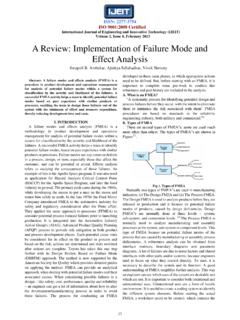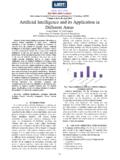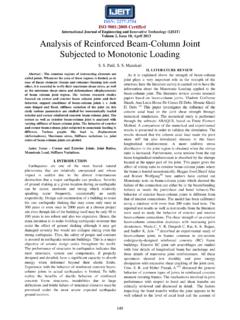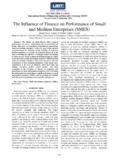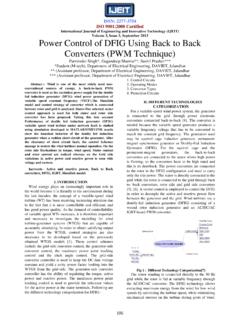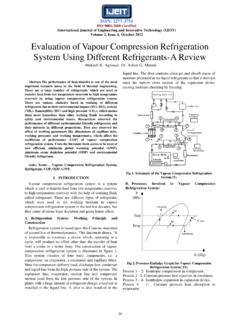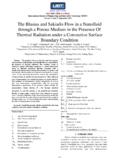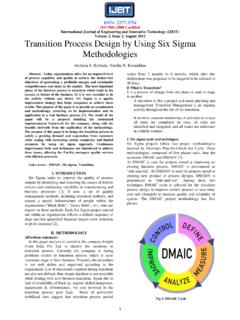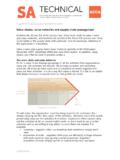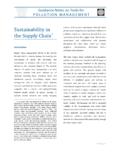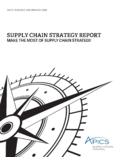Transcription of Improvement of Logistics and Supply Chain …
1 ISSN: 2277-3754 ISO 9001:2008 Certified International Journal of Engineering and Innovative Technology (IJEIT) Volume 4, Issue 10, April 2015 109 Improvement of Logistics and Supply Chain Management in the Cement Industry: a Literature ReviewPiyush Shukla, Lochan Sharma , Department of Industrial Engineering, LPU, Punjab-144411 Assistant Professor, Department of Industrial Engineering, LPU, Punjab-144411 Abstract:-The present research aims to investigate the effects of Supply Chain management in Indian cement industries using a Qualitative data collection techniques & logistic Management. These data were analysed using SWOT analysis. The outcomes of the analysis are the peculiar features of the practice of Supply Chain Management in Indian cement industry. the optimal Supply Chain strategy demonstrates the best economic, ecological and social performance in the cement industry.
2 Since 2000, Supply Chain management has played an operational role within cement and mineral extraction commodity companies. Recently, cost reduction projects have brought Supply Chain management into the limelight. The level of advancement in cement Supply Chain Management (SCM) can facilitate or constrain indian economic development. Logistics Management also plays important roles and contribute immensely to the economy of a nation. Research was conducted to investigate how Logistics and Supply chains are implemented in cement factories in India. The cement industries are playing vital role in the economic and social development of the countries. The Indian cement industry chosen for this study is the biggest cement industries in the country. Keywords:-Cement Industries, Supply Chain Management, SWOT Analysis, Logistic Management. I. INTRODUCTION The Research will explore the strengths, weaknesses, opportunities and threats in Indian Cement Company Logistics aspect and its Logistics process.
3 Supply Chain management has been defined as the design, planning, execution, control, and monitoring of Supply Chain activities with the objective of creating net value, building a competitive infrastructure, leveraging worldwide Logistics , synchronizing Supply with demand and measuring performance globally . As defined by Heizer and Render Supply Chain management is the integration of the activities that procure materials and services, transform them into intermediate goods and final products and deliver them to the customers . Cement is the second most consumed substance in the world after water. It is irreplaceable ingredient in a vast majority of the applications needed in our daily life. For instance, civil infrastructure projects, houses, power generation plants and many more cannot be built without it. In general, cement is a mixture of limestone, sand, shell, clay and iron.
4 Famous example is the Normal Portland cement which is the most common type used World-wide. Different types of cement produced in India: Ordinary Portland cement (OPC): This is by far the most common cement used in general concrete construction when there is no exposure to sulphates in the soil or in ground water. In consequence, modern cements have higher 28 days strength than the past, but the later gain in strength is smaller. Portland Pozzolana Cement (PPC): contains up to 35% fly ash. The fly ash is pozzolanic, so that ultimate strength is maintained. Because fly ash addition allows lower concrete water content, early strength can also be maintained. Portland Slag Cement (PSC): contains up to 70% ground granulated blast furnace slag, with the rest Portland clinker and a little gypsum. All compositions produce high ultimate strength, but as slag content is increased, early strength is reduced, while sulphate resistance increases and heat evolution diminishes.
5 SWOT analysis is a strategic tool that can help companies analyse their situation and conditions they are faced with, summarize for their past and make a developing strategy and plan for future life and evaluate. S stands for strengths, W stands for weaknesses, O stands for opportunities, T stands for threats. Strengths and weaknesses belong to internal factors and opportunities and threats are external factors. Logistics management is the part of Supply Chain management that plans, implements, and controls the efficient, effective forward, and reverse flow and storage of goods, services, and related information between the point of origin and the point of consumption in order to meet customer's requirements. A professional working in the field of Logistics management is called a logistician. Fig 1. Supply Chain Management-Main Component ISSN: 2277-3754 ISO 9001:2008 Certified International Journal of Engineering and Innovative Technology (IJEIT) Volume 4, Issue 10, April 2015 110 II.
6 LITERATURE SURVEY Deepesh Giri Sharma, G K Sahu(2014)performed a reviewing Study on The Outcomes of the analysis are the peculiar features of the practice of Supply Chain Management in the Indian cement industry. Using SWOT analysis cement manufacturing firm and covered its manufacturing units, sales units, marketing offices, warehousing, Logistics , procurement, finance, inventory and environment in order to know the SCM practices. According to the Council of Supply Chain Management Professionals (CSCMP), Supply Chain management encompasses the planning and management of all activities involved in sourcing, procurement, conversion, and Logistics management. It also includes the crucial components of coordination and collaboration with channel partners, which can be suppliers, intermediaries, third-party service providers, and customers.
7 In essence, Supply Chain management integrates Supply and demand management within and across companies. Fig 2. Data Collection Methods The conclusion drawn from this Study project is as follow: 1. To know what is strengths, weaknesses, opportunities and threats in entire Indian cement firm or company. 2. The key learning of the study suggest that there is a bunch of Supply Chain management Good practices exists in the Indian cement industry. 3. The Indian cement industry is seeking implementation of green Supply Chain measures to effectively address these issues. B. T. D. PRAVEEN VARMA, (2013) The purpose of this study project is about the cement manufacturing process, defining the different stages and Equipment used in the process. Mainly cement industries are focusing on Portland type cement and manufacturing in a different type of Portland cement. Indian cement industries are also producing same type of cement and following the different stages.
8 Generally cement industries are following the seven stages:- Stage1:- Opencast lime stone mining Stage-2. Lime stone crushing & stacking Material Handling & Grinding Stage-4. Coal Grinding Stage -5. Preheater kiln & cooler Stage -6. Clinker grinding (cement mill) Stage-7 Packing plant & loading plant Fig 3. Cemex industries process Bernd Noche and Tarek Elhasia (2013) Analysis & model simulation to innovative Supply Chain strategies in cement industry. Cement is the second most consumed substance in the world after water. It is irreplaceable ingredient in a vast majority of the applications needed in our daily life. To gain better understanding about the nature of SCM in cement industry and its behaviour many tools can be used, for instance, SCOR-Model, ABC Analysis and Operational Performance Triangles. Background simulation analysis Supply Chain modelling SCOR-Model Supply - Chain Operations Reference (SCOR) Model is another tool.
9 It is used as benchmark tool to analyse the cement Supply Chain processes. In general, SCOR Model is a cross-functional framework for evaluating and comparing Supply Chain activities. ABC (Always Better Control) Analysis This tool is used to help Supply Chain integration and Push-Pull boundary decision according to seasonal demand and Reorder Points ROP. ABC-Analysis is a range of items which have different levels of significance and should be handled or controlled differently. Class-A= clinker is a primary product Class-B= bulk cement Class-C =Cement in bags Operational performance triangles Performance triangles could identify the actual position of Company within their Competitors in the target market. Supply Chain strategy execution needs to balance the operational performance objectives which are classified in three groups: (Customer Response; Efficiency; Asset Utilization).
10 Vonderembse et al. (2006) discussed three types of Supply chains that are necessary to match three types of products: standard, innovative, and hybrid. They demonstrate that standard products, which tend to be simple products with limited amounts of differentiation, should be produced by a lean Supply Chain . Lean Supply Chain employ continuous Improvement efforts and focus ISSN: 2277-3754 ISO 9001:2008 Certified International Journal of Engineering and Innovative Technology (IJEIT) Volume 4, Issue 10, April 2015 111 on eliminating wastes across the Supply Chain . On the other hand, innovative products which may employ new and complex technology require an agile Supply Chain . Agile Supply Chain responds to rapidly changing global markets by being dynamic and flexible across organizations. Hybrid products, which are complex products, have many components and participating companies in the Supply Chain ; therefore, a variety of supplier relationships may be needed, which they refer to hybrid Supply chains.
